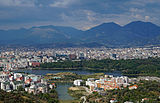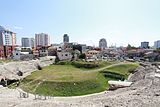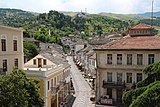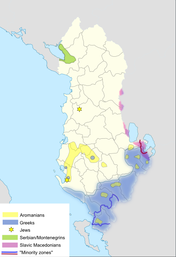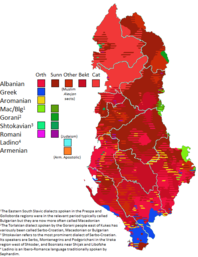Albania
Republic of Albania Republika e Shqipërisë (Albanian) | ||
|---|---|---|
| Motto: Ti Shqipëri, më jep nder, më jep emrin Shqipëtar "You Albania, give me honour, you give me the name Albanian" | ||
| Anthem: "Himni i Flamurit" "Hymn to the Flag" | ||
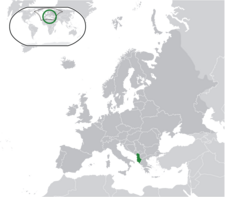 Location of Albania (green) | ||
| Capital and largest city | Tirana 41°19′N 19°49′E / 41.317°N 19.817°E | |
| Official languages | Albanian | |
| Recognised minority languages | ||
| Religion (2020) |
| |
| Demonym(s) | Albanian | |
| Government | Unitary parliamentary republic | |
| Bajram Begaj | ||
| Edi Rama | ||
| Lindita Nikolla | ||
| Legislature | 2nd Republic of Albania | 10 January 1946 |
| 28 December 1976 | ||
• 4th Republic of Albania | 29 April 1991 | |
| 28 November 1998 | ||
| Area | ||
• Total | 28,748 km2 (11,100 sq mi) (140th) | |
• Water (%) | 4.7 | |
| Population | ||
• January 2022 estimate | ||
• 2011 census | 2,821,977[3] | |
• Density | 97/km2 (251.2/sq mi) | |
| GDP (PPP) | 2024 estimate | |
• Total | ||
• Per capita | ||
| GDP (nominal) | 2024 estimate | |
• Total | ||
• Per capita | ||
| Gini (2019) | medium | |
| HDI (2022) | high (74th) | |
| Currency | Lek (ALL) | |
| Time zone | UTC+1 (CET) | |
• Summer (DST) | UTC+2 (CEST) | |
| Driving side | right | |
| Calling code | +355 | |
| ISO 3166 code | AL | |
| Internet TLD | .al | |
Albania (.
In ancient times, the
Since its independence in 1912, Albania has undergone a diverse political evolution, transitioning from a
Name
The historical origins of the term "Albania" can be traced back to
The Byzantine historian
History
Prehistory
Mesolithic habitation in Albania has been evidenced in several open air sites which during that period were close to the Adriatic coastline and in cave sites. Mesolithic objects found in a cave near Xarrë include
The
Antiquity
The incorporated territory of Albania was historically inhabited by
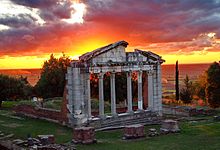
The Illyrian Taulanti were a powerful Illyrian tribe that were among the earliest recorded tribes in the area. They lived in an area that corresponds much of present-day Albania. Together with the Dardanian ruler Cleitus, Glaucias, the ruler of the Taulantian kingdom, fought against Alexander the Great at the Battle of Pelium in 335 BC. As the time passed, the ruler of Ancient Macedonia, Cassander of Macedon captured Apollonia and crossed the river Genusus (Albanian: Shkumbin) in 314 BC. A few years later Glaucias laid siege to Apollonia and captured the Greek colony of Epidamnos.[35]
The Illyrian
Middle Ages

The
In the 11th century, the
and Dhimitri.Upon the death of Dhimiter, the territory came under the rule of the Albanian-Greek
Towards the end of the 12th and beginning of the 13th centuries,
After the dissolution of Arbanon,
Ottoman Empire
With the
A prosperous and longstanding revolution erupted after the formation of the
Despite his brilliance as a military leader, Skanderbeg's victories were only delaying the final conquests. The constant Ottoman invasions caused enormous destruction to Albania, greatly reducing the population and destroying flocks of livestock and crops. Besides surrender, there was no possible way Skanderbeg would be able to halt the Ottoman invasions despite his successes against them. His manpower and resources were insufficient, preventing him from expanding the war efforts and driving the Turks from the Albanian borders. Albania was therefore doomed to face an unending series of Ottoman attacks until it eventually fell years after his death.[63]
When the Ottomans were gaining a firm foothold in the region, Albanian towns were organised into four principal
The phenomenon of Islamisation among the Albanians became primarily widespread from the 17th century and continued into the 18th century.[65] Islam offered them equal opportunities and advancement within the Ottoman Empire. However, motives for conversion were, according to some scholars, diverse depending on the context though the lack of source material does not help when investigating such issues.[65] Because of increasing suppression of Catholicism, most Catholic Albanians converted in the 17th century, while Orthodox Albanians followed suit mainly in the following century.
Since the Albanians were seen as strategically important, they made up a significant proportion of the
Rilindja
The
The victory of Russia over the Ottoman Empire following the
Approximately 300 Muslims participated in the assembly composed by delegates from Bosnia, the
Ottomans authorities cancelled their assistance when the league, under
Independence
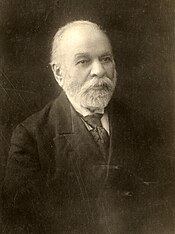
Albania
Headquartered in Vlorë, the
In November 1913, the Albanian pro-Ottoman forces had offered the throne of Albania to the Ottoman war minister of Albanian origin,
In February 1914, the
First Republic

The interwar period in Albania was marked by persistent economic and social difficulties, political instability and foreign interventions.[91][92] After World War I, Albania lacked an established government and internationally recognized borders, rendering it vulnerable to neighboring entities such as Greece, Italy, and Yugoslavia, all of which sought to expand their influence.[91] This led to political uncertainty, highlighted in 1918 when the Congress of Durrës sought Paris Peace Conference protection but was denied, further complicating Albania's position on the international stage. Territorial tensions escalated as Yugoslavia, particularly Serbia, sought control of northern Albania, while Greece aimed dominance in southern Albania. The situation deteriorated in 1919 when the Serbs launched attacks on Albanian inhabitants, among others in Gusinje and Plav, resulting in massacres and large-scale displacement.[91][93][94] Meanwhile, Italian influence continued to expand during this time, driven by economic interests and political ambitions.[92][95]
In 1939, Italy under Benito Mussolini launched a military invasion of Albania, resulting to the exile of Zog and the creation of an Italian protectorate.[96][97] As World War II progressed, Italy aimed to expand its territorial dominion in the Balkans, including territorial claims on regions of Greece (Chameria), Macedonia, Montenegro and Kosovo. These ambitions laid the foundation of Greater Albania, which aimed to unite all areas with Albanian-majority populations into a single country.[98] In 1943, as Italy's control declined, Nazi Germany assumed control of Albania, subjecting Albanians to forced labor, economic exploitation and repression under German rule.[99] The tide shifted in 1944 when Albanian partisan forces, under the leadership of Enver Hoxha and other communist leaders, successfully liberated Albania from German occupation.[100]
Communism
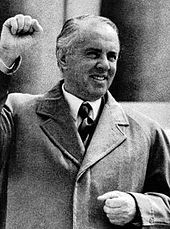
The establishment of the People's Republic of Albania under the leadership of Enver Hoxha was a significant epoch in modern Albanian history.[101] Hoxha's regime embraced Marxist–Leninist ideologies and implemented authoritarian policies, including prohibition of religious practices, severe restrictions on travel, and abolition of private property rights.[102] It was also defined by a persistent pattern of purges, extensive repression, instances of betrayal, and hostility to external influences.[102] Any form of opposition or resistance to his rule was met with expeditious and severe consequences, such as internal exile, extended imprisonment, and execution.[102] The regime confronted a multitude of challenges, including widespread poverty, illiteracy, health crises and gender inequality.[100] In response, Hoxha initiated a modernization initiative aimed at attaining economic and social liberation and transforming Albania into an industrial society.[100] The regime placed a high priority on the diversification of the economy through Soviet-style industrialization, comprehensive infrastructure development such as the introduction of a transformative railway system, expansion of education and healthcare services, elimination of adult illiteracy, and targeted advancements in areas such as women's rights.[103][104][105][106]

Albania's diplomatic history under Hoxha was characterized by notable conflicts.[91] Initially aligned with Yugoslavia as a satellite state, the relationship deteriorated as Yugoslavia aimed to incorporate Albania within its territory.[91] Subsequently, Albania established relations with the Soviet Union and engaged trade agreements with other Eastern European countries, but experienced disagreements over Soviet policies, leading to strained ties with Moscow and diplomatic separation in 1961.[91] Simultaneously, tensions with the West heightened due to Albania's refusal to hold free elections and allegations of Western support for anti-communist uprisings. Albania's enduring partnership was with China; it sided with Beijing during the Sino-Soviet conflict, resulting in severed ties with the Soviet Union and withdrawal from the Warsaw Pact in response to the invasion of Czechoslovakia in 1968. But their relations stagnated in 1970, prompting both to reassess their commitment, and Albania actively reduced its dependence on China.[91]
Under Hoxha's regime, Albania underwent a widespread campaign targeting religious clergy of various faiths, resulting in public persecution and executions, particularly targeting Muslims, Roman Catholics and Eastern Orthodox adherents.[91] In 1946, religious estates underwent nationalization, coinciding with the closure or transformation of religious institutions into various other purposes.[91] This culminated in 1976, when Albania became the world's first constitutionally atheist state.[108] Under this regime, Albanians were forced to renounce their religious beliefs, adopt a secular way of life, and embrace socialist ideology.[91][108]
Fourth Republic

After four decades of communism paired with the
The schemes began to collapse in late 1996, leading many of the investors to join initially peaceful protests against the government, requesting their money back. The protests turned violent in February 1997 as government forces responded by firing on the demonstrators. In March, the Police and Republican Guard deserted, leaving their armories open. These were promptly emptied by militias and criminal gangs. The resulting
The crisis led both
Contemporary
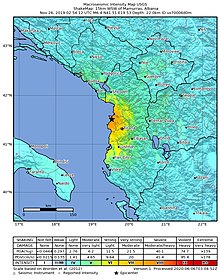
After its
On 26 November 2019, a 6.4
On 9 March 2020, COVID-19 was confirmed to have spread to Albania.[127][128] From March to June 2020, the government declared a state of emergency as a measure to limit the virus's spread.[129][130][131] The country's COVID-19 vaccination campaign started on 11 January 2021, but as of 11 August 2021, the total number of vaccines administered in Albania was 1,280,239 doses.[132][133]
Environment
Geography
Albania lies along the
Albania has a diverse and varied landscape with mountains and hills that traverse its territory in various directions. The country is home to extensive mountain ranges, including the
Climate
The
Albania receives most of the
Biodiversity
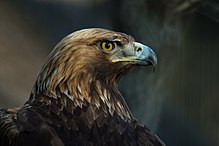
A
The estuaries, wetlands and lakes are extraordinarily important for the greater flamingo, pygmy cormorant and the extremely rare and perhaps the most iconic bird of the country, the dalmatian pelican.[152] Of particular importance are the Mediterranean monk seal, loggerhead sea turtle and green sea turtle that use to nest on the country's coastal waters and shores.
In terms of phytogeography, Albania is part of the Boreal Kingdom and stretches specifically within the Illyrian province of the Circumboreal and Mediterranean Region. Its territory can be subdivided into four terrestrial ecoregions of the Palearctic realm namely within the Illyrian deciduous forests, Balkan mixed forests, Pindus Mountains mixed forests and Dinaric Mountains mixed forests.[153][154]
Approximately 3,500 different species of plants can be found in Albania which refers principally to a
Conservation

Albania has been an active participant in numerous international agreements and conventions aimed at strengthing its commitment to the preservation and sustainable management of biological diversity. Since 1994, the country is a party to the Convention on Biological Diversity (CBD) and its associated Cartagena and Nagoya Protocols.[156] To uphold these commitments, it has developed and implemented a comprehensive National Biodiversity Strategy and Action Plan (NBSAP).[156] Furthermore, Albania has established a partnership with the International Union for Conservation of Nature (IUCN), advancing its conservation efforts on both national and international scales. Guided by the IUCN, the country has made substantial progress in the foundation of protected areas within its boundaries, encompassing 12 national parks among others Butrint, Karaburun-Sazan, Llogara, Prespa and Vjosa.[157]
As a signatory to the
Protected areas
The
To the south, the
Environmental issues
Environmental issues in Albania notably encompass
As a party to the
Politics

|

|
| Bajram Begaj President |
Edi Rama Prime Minister |
Since declaring independence in 1912, Albania has experienced a significant political transformation, traversing through distinct periods that included a monarchical rule, a communist regime and the eventual establishment of a democratic order.
Albania's legal system is structured to protect its people's political rights, regardless of their ethnic, linguistic, racial, or religious affiliations.[174][176] Despite these principles, there are significant human rights concerns in Albania that demand attention.[177] These concerns include issues related to the independence of the judiciary, the absence of a free media sector and the enduring problem of corruption within various governmental bodies, law enforcement agencies and other institutions.[177] As Albania pursues its path toward EU membership, active efforts are being made to achieve substantial improvements in these areas to align with EU criteria and standards.[176]
Foreign relations
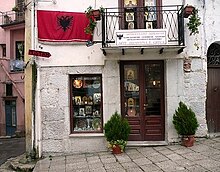
Emerging from decades of isolation during the communism, Albania has adopted a
The external affairs of Albania underscore the country's dedication to regional stability and integration into major international institutions.[180] Albania became a member of the United Nations (UN) in 1955, shortly after emerging from a period of isolation during the communist era.[181] The country reached a major achievement in its foreign policy by securing membership in the North Atlantic Treaty Organization (NATO) in 2009.[182][183] Since obtaining candidate status in 2014, the country has also embarked on a comprehensive reform agenda to align itself with European Union (EU) accession standards, with the objective of becoming an EU member state.[119]
Albania and Kosovo maintain a fraternal relationship strengthened by their substantial cultural, ethnical and historical ties.[184] Both countries foster enduring diplomatic ties, with Albania actively supporting Kosovo's development and international integration efforts.[184] Its fundamental contribution to Kosovo's path to independence is underscored by its early recognition of Kosovo's sovereignty in 2008.[185] Furthermore, both governments hold annual joint meetings, displayed by the inaugural meeting in 2014, which serves as an official platform to enhance bilateral cooperation and reinforce their joint commitment to policies that promote the stability and prosperity of the broader Albanian region.[184]
Military
The
The chief purpose of the armed forces of Albania is the defence of the independence, the sovereignty and the territorial integrity of the country, as well as the participation in humanitarian, combat, non-combat and peace support operations.[186] Military service is voluntary since 2010 with the age of 19 being the legal minimum age for the duty.[187][188]
Albania has committed to increase the participations in multinational operations.
Albania reduced the number of active troops from 65,000 in 1988 to 14,500 in 2009.[192][193] The military now consists mainly of a small fleet of aircraft and sea vessels. Increasing the military budget was one of the most important conditions for NATO integration. As of 1996 military spending was an estimated 1.5% of the country's GDP, only to peak in 2009 at 2% and fall again to 1.5%.[194]
Administrative divisions
Albania is defined within a territorial area of 28,748 km2 (11,100 sq mi) in the
The counties are made up of 61 second-level divisions known as
| Emblem | County | Capital | Area (km2) |
Population (2020) | HDI (2019) | ||||||||||||||
|---|---|---|---|---|---|---|---|---|---|---|---|---|---|---|---|---|---|---|---|
| Berat | Berat | 1,798 | 122,003 | 0.782 | |||||||||||||||
| Dibër | Peshkopi | 2,586 | 115,857 | 0.754 | |||||||||||||||
| Durrës | Durrës | 766 | 290,697 | 0.802 | |||||||||||||||
| Elbasan | Elbasan | 3,199 | 270,074 | 0.784 | |||||||||||||||
| Fier | Fier | 1,890 | 289,889 | 0.767 | |||||||||||||||
| Gjirokastër | Gjirokastër | 2,884 | 59,381 | 0.794 | |||||||||||||||
| Korçë | Korçë | 3,711 | 204,831 | 0.790 | |||||||||||||||
| Kukës | Kukës | 2,374 | 75,428 | 0.749 | |||||||||||||||
| Lezhë | Lezhë | 1,620 | 122,700 | 0.769 | |||||||||||||||
| Shkodër | Shkodër | 3,562 | 200,007 | 0.784 | |||||||||||||||
| Tirana | Tirana | 1,652 | 906,166 | 0.820 | |||||||||||||||
| Vlorë | Vlorë | 2,706 | 188,922 | 0.802 | |||||||||||||||
| References:[204][205] | |||||||||||||||||||
Economy
This section needs to be updated. (May 2023) |

Albania's transition from a socialist
The cities of
In 2012, Albania's
Primary sector
Agriculture in the country is based on small to medium-sized family-owned dispersed units. It remains a significant sector of the economy of Albania. It employs 41%[212] of the population, and about 24.31% of the land is used for agricultural purposes. One of the earliest farming sites in Europe has been found in the southeast of the country.[213] As part of the pre-accession process of Albania to the European Union, farmers are being aided through IPA funds to improve Albanian agriculture standards.[214]
Albania produces significant amounts of fruits (apples,
Albania has one of Europe's longest histories of viticulture.[216] Today's region was one of the few places where vine was naturally grown during the ice age. The oldest found seeds in the region are 4,000 to 6,000 years old.[217] In 2009, the nation produced an estimated 17,500 tonnes of wine.[218]
Secondary sector

Albania's secondary sector has undergone many changes and diversification since the communist regime collapsed. It is very diversified, from
Albania is a significant minerals producer and ranks among the world's leading chromium producers and exporters.[224] The nation is also a notable producer of copper, nickel, and coal.[225] The Batra mine, Bulqizë mine, and Thekna mine are among the most recognized Albanian mines still in operation.
Tertiary sector
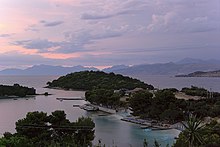
The
Previously one of the most
Tourism is recognised as an industry of national importance and has been steadily increasing since the beginnings of the 21st century.[228][229] It directly accounted for 8.4% of GDP in 2016 though including indirect contributions pushes the proportion to 26%.[230] In the same year, the country received approximately 4.74 million visitors mostly from across Europe and the United States as well.[231]
The increase of foreign visitors has been dramatic. Albania had only 500,000 visitors in 2005, and an estimated 4.2 million in 2012, an increase of 740 percent. In 2015, summer tourism increased by 25 percent from 2014, according to the country's tourism agency.[232] In 2011, Lonely Planet named Albania as a top travel destination,[233][failed verification] while The New York Times placed Albania as number 4 global tourist destination in 2014.[234]
The bulk of the tourist industry is concentrated along the
Transport
Transportation in Albania is managed within the functions of the Ministry of Infrastructure and Energy and entities such as the Albanian Road Authority (ARRSH), responsible for the construction and maintenance of the highways and motorways in Albania, as well as the Albanian Aviation Authority (AAC), with the responsibility of coordinating civil aviation and airports in the country.
The
The
with the Pan-European Corridor VIII. When all three corridors are completed, Albania will have an estimated 759 kilometres (472 mi) of highway, linking it with all neighboring countries.The rail network is administered by the national railway company Hekurudha Shqiptare, which was extensively promoted by Hoxha. There has been considerable increase in private car ownership and bus usage while rail use decreased since the end of communism. A new railway line from Tirana and its airport to Durrës is planned. The location of this railway, connecting Albania's most populated urban areas, makes it an important economic development project.[241][242]
Infrastructure
Education
In Albania, education is secular, free,
Compulsory primary education is divided into two levels, elementary and secondary school, from grade one to five and six to nine, respectively.[243] Pupils are required to attend school from the age six until they turn 16. Upon successful completion of primary education, all pupils are entitled to attend high schools, specializing in any field, including arts, sports, languages, sciences, and technology.[243]
Tertiary education is optional and has undergone a thorough reformation and restructuring in compliance with the principles of the
Health

The
In 2009, Albania had a fruit and vegetable supply of 886 grams per capita per day, the fifth-highest supply in Europe.
Energy

Due to its location and natural resources, Albania has a wide variety of
Albania has considerable oil deposits. It has the 10th-largest oil reserves in Europe and the 58th in the world.
Albania's
Media
The
Albanian cinema has its roots in the 20th century and developed after the country's
Technology
After the
Telecommunication represents one of the fastest growing and dynamic sectors in Albania.
Demography
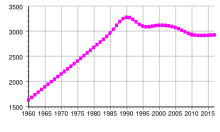
As defined by the
The explanation for the recent population decrease is the fall of communism in Albania in the late twentieth century. That period was marked by economic mass emigration from Albania to Greece, Italy and the United States. The migration affected the country's internal population distribution. It decreased particularly in the north and south, while it increased in the centre within the cities of Tirana and Durrës.[citation needed] Migration abroad has continued in recent years, particularly of the young and educated. As much as a third of those born in the country's borders now live outside of it, making Albania one of the countries with the highest rate of outmigration relative to its population in the world.[297][298] In 2022 the birth rate was 20% lower than in 2021, largely due to emigration of people of childbearing age.[299]
About 53.4% of the country's
| # | City | Population | # | City | Population | ||
|---|---|---|---|---|---|---|---|
| 1 | Tirana | 418,495 | 11 | Kavajë | 20,192 | ||
| 2 | Durrës | 113,249 | 12 | Gjirokastër | 19,836 | ||
| 3 | Vlorë | 79,513 | 13 | Sarandë | 17,233 | ||
| 4 | Elbasan | 78,703 | 14 | Laç | 17,086 | ||
| 5 | Shkodër | 77,075 | 15 | Kukës | 16,719 | ||
| 6 | Fier | 55,845 | 16 | Patos |
15,937 | ||
| 7 | Korçë | 51,152 | 17 | Lezhë | 15,510 | ||
| 8 | Berat | 32,606 | 18 | Peshkopi | 13,251 | ||
| 9 | Lushnjë | 31,105 | 19 | Kuçovë | 12,654 | ||
| 10 | Pogradec | 20,848 | 20 | Krujë | 11,721 | ||
Minorities
This section needs to be updated. (May 2023) |
Albania recognises nine national or cultural minorities:
Regarding the Greeks, estimates vary between 60,000 and 300,000 ethnic Greeks in Albania. According to Ian Jeffries, most Western sources put the number at around 200,000. The 300,000 mark is supported by Greek government as well.
Language
This section needs to be updated. (May 2023) |

The
Among young people aged 25 or less, English, German and Turkish have seen rising interest after 2000. Italian and French have had a stable interest, while Greek has lost much of its previous interest. The trends are linked with cultural and economic factors.[321]
Young people have shown a growing interest in the German language in recent years.[citation needed] Some of them go to Germany for studying or various experiences. Albania and Germany have agreements for cooperating in helping young people of the two countries know both cultures better.[322] Due to a sharp rise in economic relations with Turkey, interest in learning Turkish, in particular among young people, has been growing on a yearly basis.[323]
Religion
This section needs to be updated. (July 2020) |
Religion in Albania as of the 2011 census conducted by the Institute of Statistics (INSTAT)[324]
Albania is a
The preliminary results of the 2011 census seemed to give widely different results, with 70% of respondents refusing to declare belief in any of the listed faiths.

During
Islam survived communist era persecution and reemerged in the modern era as a practised religion in Albania.
Culture
Symbols

The red and black
The coat of arms of Albania is an adaptation of the flag of Albania and the seal of Skanderbeg.[346] The coat comprises the black double-headed eagle positioned at the center of a red field.[346] Above the eagle, it carries the helmet of Skanderbeg that is crowned with the head of a golden horned goat.[348] Ti Shqipëri, më jep nder, më jep emrin Shqipëtar, which translates to "You Albania, give me honor, give me the name Albanian", is the national motto of Albania.[347][348] It finds its foundation in the legacy of national poet Naim Frashëri, who held a renowned role during the Albanian Renaissance.[347] The national anthem of Albania, "Himni i Flamurit", was composed by Asdreni and adopted as such following Albania's independence in 1912.[346]
Clothing
Albanian traditional clothing, with its contrasting variations for the northern Gheg and southern Tosk Albanians, is a testament to Albania's history, cultural diversity and ethnic identity.[352] Gheg men wear a light-colored shirt paired with wide loose-fitting trousers referred to as the Tirq. These trousers are securely fastened by a wide woven belt, the Brez. An integral component of their costume is the Xhamadan, a woolen red velvet vest adorned with folkloric motifs and gold patterns.[353] They also wear a distinctive dome-shaped hat known as the Qeleshe, crafted from wool, with its origins tracing back to the Illyrians.[354][355] Conversely, Tosk men opt for the Fustanella, a knee-length garment designated as the national costume, typically white with pleats, accompanied by a white shirt. They also wear a beige or dark blue Xhamadan reminiscent of the Gheg attire. To complete their attire, men wear knee-high socks referred to as Çorape and leather shoes known as Opinga.
The attire of Gheg and Tosk women is renowned for its rich palette of colors and intricate filigree detailing, displayed across various components including ear ornaments, finger rings, necklaces, belt buckles and buttons. Key components include a long, light-toned shirt paired with an apron, often accompanied by a woolen or felt mantle referred to as the Xhoka. Additional upper garments, such as the Dollama or Mintan, may be layered, along with a headscarf known as Kapica or Shall. A distinctive variation incorporates a pair of aprons, including the Pështjellak at the rear and the Paranik at the front. Integral to the traditional attire of Gheg women is the ancient Xhubleta.[352] Dedicated efforts have been undertaken to preserve and promote the dress, acknowledging its significance as an emblem of Albanian heritage.[356] As a testament to its importance, the Xhubleta has been inscribed on the UNESCO Intangible Cultural Heritage List.[356] The distinctive bell-shaped garment is fashioned in black and enriched with embroidered ethnic Albanian motifs, showcasing the remarkable craftsmanship of northern Albania.[352] Its crafting process involves multiple intricate stages, encompassing the preparation of shajak fabric and the precise cutting techniques.[356]
Art and architecture
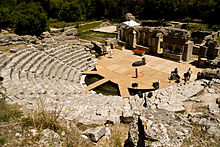
The
The rise of the
The

A productive period of Historicism, Art Nouveau and Neoclassicism merged into the 19th century, best exemplified in Korçë. The 20th century brought new architectural styles such as the modern Italian style, which is present in Tirana such as the Skanderbeg Square and Ministries. It is also present in Shkodër, Vlorë, Sarandë and Durrës. Moreover, other towns received their present-day Albania-unique appearance through various cultural or economic influences.
Three Albanian archaeological sites are included in the list of
Cuisine

Throughout the centuries,
Albanians produce and use many varieties of fruits such as
With a coastline along the
Petulla, a traditional fried dough, is also a popular speciality, and is served with
Coffee is an integral part of the Albanian lifestyle. The country has more coffee houses per capita than any other country in the world.[363] Tea is also enjoyed both at home or outside at cafés, bars, or restaurants. Çaj Mali (Sideritis tea) is enormously beloved, and a part of the daily routine for most Albanians. It is cultivated across Southern Albania and noted for its medicinal properties. Black tea is also popular.
Albanian wine is also common throughout the country, and has been cultivated for thousands of years. Albania has a long and ancient history of wine production, and belongs to the Old World of wine producing countries.[364][365]
Music
Albanian folk music is a prominent part of the national identity, and continues to play a major part in overall Albanian music. Folk music can be divided into two stylistic groups, mainly the northern Gheg varieties, and southern Lab and Tosk varieties. Northern and southern traditions are contrasted by a rugged tone from the north, and the more relaxed southern form of music.
Many songs concern events from
Contemporary artists
Literature
This section needs additional citations for verification. (October 2018) |
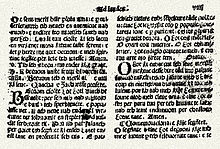
The cultural renaissance was first of all expressed through the development of the Albanian language in the area of church texts and publications. The Protestant reforms invigorated hopes for the development of the local language and literary tradition, when cleric Gjon Buzuku translated the Catholic liturgy into Albanian, trying to do for Albanian what Martin Luther had done for German. Meshari (The Missal) written by Gjon Buzuku was published in 1555 and is considered one of the first literary work of written Albanian during the Middle Ages. The refined level of the language and the stabilised orthography must be the result of an earlier tradition of written Albanian, a tradition that is not well understood. However, there is some fragmented evidence, pre-dating Buzuku, which indicates that Albanian was written from at least the 14th century.

Albanian writings from these centuries must not have been religious texts only, but historical chronicles too. They are mentioned by the humanist
During the 16th and the 17th centuries, the
Sports
Albania participated at the

Popular sports in Albania include
The
.Weightlifting is one of the most successful individual sport for the Albanians, with the national team winning medals at the European Weightlifting Championships and the rest international competitions. Albanian weightlifters have won a total of 16 medals at the European Championships with 1 of them being gold, 7 silver and 8 bronze. In the World Weightlifting Championships, the Albanian weightlifting team has won in 1972 a gold in 2002 a silver and in 2011 a bronze medal.
Diaspora
Historically, the Albanian people have established several communities in many regions throughout Southern Europe. The Albanian diaspora has been formed since the late Middle Ages, when they emigrated to places such as Italy, especially in Sicily and Calabria, and Greece to escape either various socio-political difficulties or the Ottoman conquest of Albania.[374] Following the fall of communism, large numbers of Albanians have migrated to countries such as Australia, Canada, France, Germany, Greece, Italy, Scandinavia, Switzerland, the United Kingdom and the United States. Albanian minorities are present in the neighbouring territories such as the west of North Macedonia, the east of Montenegro, Kosovo in its entirety and southern Serbia. In Kosovo, Albanians are the largest ethnic group in the country. Altogether, the number of ethnic Albanians living abroad is estimated to be higher than the total population inside Albania.
See also
Notes
- ^ pronounced [ɾɛpuˈblika ɛ ʃcipəˈɾisə].
References
- ^ "Albania". The World Factbook (2024 ed.). Central Intelligence Agency. Retrieved 1 November 2021. (Archived 2021 edition.)
- ^ "Popullsia e Shqipërisë" (in Albanian). Instituti i Statistikës (INSTAT). 26 March 2020. Archived from the original on 22 August 2022. Retrieved 22 August 2022.
- ^ a b c "Population and Housing Census 2011" (PDF). Instituti i Statistikës (INSTAT). Archived from the original (PDF) on 26 August 2020. Retrieved 21 September 2020.
- ^ a b c d "World Economic Outlook Database, October 2023 Edition. (Albania)". IMF.org. International Monetary Fund. 10 October 2023. Retrieved 11 October 2023.
- ^ "Gini coefficient of equivalised disposable income – EU-SILC survey". ec.europa.eu. Eurostat. Retrieved 12 August 2021.
- ^ "Human Development Report 2023/24" (PDF). United Nations Development Programme. 13 March 2024. Retrieved 13 March 2024.
- ^ Giacomo Jungg (1 January 1895). Fialuur i voghel scc...p e ltinisct mle...un prei P. Jak Junkut t' Scocniis ... N'Sckoder t' Scc...pniis. Retrieved 23 July 2016 – via Internet Archive.
- ISBN 978-3447108515. p. 108.
- ISBN 9780826456564.
- ^ "Albania". The World Bank. Archived from the original on 21 September 2014. Retrieved 13 September 2014.
- ^ Reports: Poverty Decreases in Albania After Years of Growth. Dow Jones Newswires, 201-938-5500 201-938-5500 201-938-5500.Nasdaq.com
- Balkan Peninsula. Rowman & Littlefield, 2007. p. 146.
- ISBN 0-691-03169-X), Map 49 & notes.
- ISBN 978-0-631-19807-9, page 279,"We cannot be certain that the Arbanon of Anna Comnena is the same as Albanopolis of the Albani, a place located on the map of Ptolemy (3.12)"
- ^ Madgearu & Gordon 2008, p. 25. "It is still disputed by scholars that those Albanoi from 1042 were Normans from Sicily, [Southern Italy], or if they are in fact the Albanoi [a large clan of that belongs to the many clans of Albanians] found in Albanian lands during this time frame."
- ^ Robert Elsei. The Albanian lexicon of Dion Von Kirkman. Earliest reference to the existence of the Albanian language, pp. 113–122.
- ^ "pinocacozza.it". pinocacozza.it. Archived from the original on 30 December 2019. Retrieved 23 November 2007.
- ^ a b Matasović, Ranko (2019). A Grammatical Sketch of Albanian for Students of Indo European (PDF). Zagreb. p. 39. Archived (PDF) from the original on 9 October 2022.
{{cite book}}: CS1 maint: location missing publisher (link) - ISBN 9783447039390.
- ^ Kristo Frasheri. History of Albania (A Brief Overview). Tirana, 1964.
- ^ Lloshi, Xhevat. "The Albanian Language" (PDF). United Nations Development Programme. Archived from the original (PDF) on 9 July 2011. Retrieved 9 November 2010.
- ^ F. Prendi, "The Prehistory of Albania", The Cambridge Ancient History, 2nd edn., vol. 3, part 1: The Prehistory of the Balkans; and the Middle East and the Aegean World, Tenth to Eighth Centuries B.C., ed. John Boardman et al. (Cambridge: Cambridge UP, 1982), 189–90.
- ^ Bunguri, Adem (2014). "Different models for the Neolithisation of Albania". Documenta Praehistorica. 32.
- ISSN 2352-409X.
- ISSN 0350-0020. Retrieved 7 January 2023.
- S2CID 251843620.
: Supplementary Materials
- ^ Gori, Maja; Recchia, Giulia; Tomas, Helen (2018). "The Cetina phenomenon across the Adriatic during the 2nd half of the 3rd millennium BC: new data and research perspectives". 38° Convegno Nazionale Sulla Preistoria, Protostoria, Storia della Daunia: 201.
- ISBN 978-0-631-19807-9, page 92, "Appian's description of the Illyrian territories records a southern boundary with Chaonia and Thesprotia, where ancient Epirus began south of river Aoous (Vjose)" also map
- ISBN 0-521-23447-6, page 261,"... down to the mouth of Aous"
- ^ ISBN 0-631-19807-5.
- ISBN 0-521-23447-6.
- ISBN 0-521-23348-8.
- ISBN 978-0-415-87396-3.
- ISBN 0-631-22242-1.
- ^ Justin, Epitome, 17.3
- ISBN 978-0-19-814815-9.
- ISBN 978-1-57607-091-8.
- ^ The History of Rome. D. Appleton & Company. 1 January 1846. p. 259.
- ISBN 978-0-631-19807-9.
- ^ Marjeta Šašel Kos, "The Illyrian King Ballaeus – Some Historical Aspects", Épire, Illyrie, Macédoine: Mélanges offerts au professeur Pierre Cabanes, ed. Danièle Berranger (Clermont-Ferrand: Presses Universitaires Blaise Pascal, 2007), 127.
- ISBN 978-1-134-58328-7.
From AD 548 onward, the lands now known as Albania began to be overrun from the north by ever-increasing ...
- ISBN 978-1-4129-2694-2
- ISBN 9780860781905.
- ^ Jireček, Konstantin; Thopia (1916). Illyrisch-albanische Forschungen. Duncker & Humblot. p. 239.
Griechen Gregorios Kamonas
- ISBN 978-0-521-36289-4.
Greco-Albanian lord Gregorios Kamonas
- ^ The Genealogist. 1980. p. 40.
- ^ Clements, John (1992), Clements encyclopedia of world governments, Vol. 10. Political Research, Inc. p. 31: "By 1190, Byzantium's power had so receded that the archon Progon succeeded in establishing the first Albanian state of the Middle Ages, a principality"
- ISBN 978-92-871-6265-6.
- ISBN 978-0-87249-977-5.
- ISBN 978-0-88033-047-3.
- ^ a b Zickel, Raymond; Iwaskiw, Walter R., eds. (1994). ""The Barbarian Invasions and the Middle Ages," Albania: A Country Study". Retrieved 9 April 2008.
- ISBN 9780810858466.
Albanoi.
- ^ Etleva, Lala (2008). Regnum Albaniae, the Papal Curia, and the Western Visions of a Borderline Nobility (PDF). Cambridge University Press. Archived (PDF) from the original on 9 October 2022.
- hdl:10022/AC:P:10297.
By 1415, after a chaotic interregnum, Sultan Mehmet I sent the military to erect the first Ottoman garrisons throughout southern Albania, establishing direct military authority in the region ... l jurisdiction over most of Albania ...
- ^ The Balkans: From Constantinople to Communism by D. Hupchick, page 110
- ISBN 978-0-313-31586-2.
- ISBN 978-0-87249-977-5.
- ^ Zickel, Raymond; Iwaskiw, Walter R. (1994). "Albania: A Country Study ("Albanians under Ottoman Rule")". Retrieved 9 April 2008.
- ISBN 978-92-871-6265-6.
- ^ Hodgkinson 2005, p. 240.
- ^ Hodgkinson 2005, p. xii.
- ^ Donald Edgar Pitcher (1968). An Historical Geography of the Ottoman Empire: From Earliest Times to the End of the Sixteenth Century. Brill. p. 88.
- ISBN 9780472082605.
- ^ a b "Arnawutluḳ." in Encyclopaedia of Islam, Second Edition. Brill Online, 2012.
- ^ a b c Clayer, Nathalie (2012). "Albania" in Encyclopaedia of Islam, Gudrun Krämer, Denis Matringe, Rokovet, John Nawas, Everett Rowson (eds.). Brill Online.
- ISBN 0-691-01078-1.
- ISBN 0-19-507673-7.
- ^ Observator Cultural. "Dor de Dunăre şi alte nostalgii cosmopolite". observatorcultural.ro (in Romanian).
- ISBN 9783039103294.
- ISBN 978-963-7326-52-3,
The position of the League in the beginning was based on religious solidarity. It was even called Komiteti i Myslimanëve të Vërtetë (The Committee of the Real Muslims) ... decisions are taken and supported mostly by landlords and people closely connected with Ottoman administration and religious authorities..
- ISBN 978-963-7326-52-3, retrieved 18 January 2011,
there were no delegates from Shkodra villayet and a few Bosnian delegates also participated. Present was also mutasarrif (administrator of sandjak) of Prizren as representative of the central authorities
- ^ Elsie, Robert. "1878 The Resolutions of the League of Prizren". albanianhistory.net. Archived from the original on 8 September 2010. Retrieved 20 February 2011.
On 10 June 1878, ... The League of Prizren, Alb. Lidhja e Prizrenit, ... On 13 June 1878, the League submitted an eighteen-page memorandum to Benjamin Disraeli, the British representative at the Congress of Berlin
- ^ "Albanian League". Encyclopædia Britannica. Retrieved 5 January 2012.
- ISBN 978-3-465-04017-0. Retrieved 24 January 2011.
From its own members congress elected a senate (Pleqësi), composed of 18 members, which assumed advisory role to the government.
- ^ Qemali, Ismail. "Ismail Kemal bey Vlora: Memoirs". Archived from the original on 17 June 2010. Retrieved 23 January 2011.
15th–28th November 1912 ...
- ^ Qemali, Ismail. "Ismail Kemal bey Vlora: Memoirs". Archived from the original on 17 June 2010. Retrieved 23 January 2011.
On the resumption of the sitting, I was elected President of the Provisional Government, with a mandate to form a Cabinet ...
- ISBN 978-3-465-04017-0. Retrieved 24 January 2011.
a provisional government, consisting of ten members and led by Vlora, was formed on 4 December.
- ^ Elsie, Robert. "1913 The Conference of London". Archived from the original on 17 July 2011. Retrieved 5 January 2012.
- ISBN 978-0-521-27459-3, retrieved 21 January 2011,
the International Commission ... had headquarters in Vlorë
- ^ Zaharia, Perikli (24 March 2003). "The post – 1989 constitutional course of south east Europe". Athens: Centre for European Constitutional Law. Archived from the original on 16 June 2011. Retrieved 22 January 2011.
- ^ Seton-Watson, R.W.; Wilson, J. Dover; Zimmern, Alfred E.; Greenwood, Arthur (10 January 2004) [1915], "III Germany", The War and Democracy (1st ed.), London: MacMillan, archived from the original on 13 November 2012,
Prince William of Wied, the first Prince of Albania
- ^ Elsie, Robert. "Albania under prince Wied". Archived from the original on 17 July 2011. Retrieved 25 January 2011.
pro-Ottoman forces ... were opposed to the increasing Western influence ... In November 1913, these forces, ... had offered the vacant Albanian throne to General Izzet Pasha ... War Minister who was of Albanian origin.
- ISBN 978-0-521-27459-3, retrieved 25 January 2011,
peasants..willing listeners to Ottoman propaganda ... attached the new regime as a tool of the beys and Christian powers
- ISBN 978-0-7156-3116-4.
the Greek Epirote population of the area refused to be incorporated into the new Albanian state and in February 1914 declared the Autonomous Republic of Northern Epirus ... in 1921 Albania was recognised as an independent sovereign state, with its borders established on their present lines.
- ISBN 978-0-8103-8879-6.
February 28 George Zographos, a former foreign minister of Greece, proclaims at Gjirokaster the establishment of the Autonomous Republic of Northern Epirus, with Zographos as president. He notifies the International Commission that his government has been established because the Great Powers have not provided the Greeks in southern Albania any guarantees for the protection of the life, property and religious freedom, and ethnic existence.
- ^ "The Efforts to settle amputated Albania state". albaniainbrief.com. Archived from the original on 1 June 2011. Retrieved 28 January 2011.
Thousands of muslim peasants, ... were exploited by their leaders Haxhi Qamili, Arif Hiqmeti, Musa Qazimi and Mustafa Ndroqi, ... to rebel
- ISBN 978-1-86064-541-9.
He gathered round him a group of discontented Muslim priests ... and proclaimed himself the savior of Albania and the Champion of Islam.
- ^ Elsie, Robert. "Albania under prince Wied". Archived from the original on 17 July 2011. Retrieved 25 January 2011.
mostly volunteers from Kosova under their leader Isa Boletini
- ^ Elsie, Robert. "Albania under prince Wied". Archived from the original on 17 July 2011. Retrieved 25 January 2011.
Panic broke out in Durrës, and the royal family sought refuge on an Italian vessel ...
- ISBN 978-3-486-55989-7.
- ^ a b c d e f g h i j k l m Zickel, Raymond; Iwaskiw, Walter R. (eds.). Albania country study (PDF). Federal Research Division, Library of Congress. Archived (PDF) from the original on 11 September 2023. Retrieved 11 September 2023.
- ^ ISBN 978-1-86064-541-9. Archived from the originalon 13 September 2023. Retrieved 13 September 2023.
- ISBN 978-0-14-196048-7. Archivedfrom the original on 13 September 2023.
- ISBN 978-0-85772-641-4. Archivedfrom the original on 13 September 2023. Retrieved 13 September 2023.
- ISBN 978-0-1992-8185-5. Archivedfrom the original on 13 September 2023. Retrieved 13 September 2023.
- ISBN 0-395-41685-X. Archivedfrom the original on 13 September 2023. Retrieved 13 September 2023.
- ISBN 0-8240-7029-1.
- ISBN 978-1-84511-308-7.
- ISBN 978-0-7864-5628-4.
The nationalist Balli Kombetar, which had fought against Italy, made a deal with the German invaders, and formed a "neutral" government in Tirana which ...
- ^ a b c "Albanian Nationalism". Encyclopædia Britannica. Retrieved 22 November 2016.
- ^ "Envery Hoxha". Encyclopædia Britannica. Retrieved 22 November 2016.
- ^ a b c "Human Rights in Post-Communist Albania". Human Rights Watch (HRW). Archived from the original on 11 September 2023. Retrieved 11 September 2023.
- ^ Fischer, Bernd (10 June 2010). "Albania and Enver Hoxha's legacy". OpenDemocracy. Archived from the original on 11 September 2023. Retrieved 11 September 2023.
- ^ Pano, Aristotel. "Panorama of the Economic-Social Development of Socialist Albania". Archived from the original on 31 May 2023. Retrieved 11 April 2012.
- ^ 40 Years of Socialist Albania, Dhimiter Picani
- ^ Qori, Arlind (22 February 2019). "From Faculty to Factory". Jacobin. Retrieved 14 March 2019.
- ^ "Hapet dosja, ja harta e bunkerëve dhe tuneleve sekretë". Archived from the original on 17 September 2017. Retrieved 11 August 2016.
- ^ ISBN 978-0-8108-6188-6.
- ^ "Report: The Elections in Albania". Commission on Security and Cooperation in Europe (CSCE). 4 April 1991. Archived from the original on 1 October 2020. Retrieved 1 October 2020.
- ^ Jarvis, Christopher (2000). "The Rise and Fall of the Albanian Pyramid Schemes". Finance and Development. 37 (1): 1.
- (PDF) from the original on 9 October 2022.
- .
- Greece, Switzerland, Germany, or North America.
- doi:10.7289/V5TD9V7K.
- ^ Burden, Brandon (December 2016). "Nato's small states: Albania as a case study" (PDF). Calhoun Naval Postgraduate School (NPS). pp. 44–60. Archived (PDF) from the original on 18 April 2021. Retrieved 16 August 2021.
- North Atlantic Treaty Organization(NATO). 7 April 2009. Retrieved 1 December 2019.
- ^ "Albania in NATO". ambasadat.gov.al. Permanent Delegation of the Republic of Albania to NATO.
- ^ "Albania – Eu-Albania relations". European Commission (EC). Archived from the original on 26 June 2013. Retrieved 1 December 2019.
- ^ a b "EU candidate status for Albania". European Commission (EC). 24 June 2014. Archived from the original on 5 May 2023. Retrieved 1 December 2019.
- ^ Shqip, Gazeta. "Ahmetaj: Premtimi për 300 mijë vende punë është mbajtur – Gazeta SHQIP Online". gazeta-shqip.com.
- ^ "PM Rama at 'Global Leader Woman' Summit". ambasadat.gov.al.
- ^ "Albania: PM Edi Rama secures third term for Socialist Party". Deutsche Welle (DW). 27 April 2021. Archived from the original on 10 June 2021. Retrieved 16 August 2021.
- ^ Crowcroft, Orlando (27 April 2021). "Edi Rama claims 'beautiful victory' in Albanian election". Euronews. Archived from the original on 30 April 2021. Retrieved 16 August 2021.
- ^ ANSS. "Albania 2019: M 6.4 – 16 km WSW of Mamurras, Albania". Comprehensive Catalog. U.S. Geological Survey. Retrieved 1 December 2019.
- ^ "Very Strong earthquake – Albania – November 26, 2019". Earthquake-Report. 26 November 2019. Archived from the original on 28 November 2019. Retrieved 1 December 2019.
- ^ "Albanians Raise $13 Million in 3 Days for Earthquake Relief". Exit News. 29 November 2019. Archived from the original on 3 August 2020. Retrieved 3 August 2020.
- ^ "Ministria e Shëndetësisë: Konfirmohen dy rastet e para me koronavirusin e ri" (in Albanian). Ministry of Health and Social Protection. 9 March 2020. Archived from the original on 23 July 2020. Retrieved 3 August 2020.
- ^ Ruci, Ani (9 March 2020). "Shqipëria preket nga virusi Corona" (in Albanian). Deutsche Welle (DW). Archived from the original on 3 August 2020. Retrieved 3 August 2020.
- ^ "Masat për koronavirusin, Rama: Nga nesër postblloqe, gjobë 5000 euro kush thyen karantinën" (in Albanian). A2 CNN. 11 March 2020. Archived from the original on 3 August 2020. Retrieved 3 August 2020.
- ^ Gjonaj, Arlinda (9 March 2020). "Rama: Mbyllja e kufijve nuk këshillohet nga OBSH, vetëm kufizime të pjesshme" (in Albanian). Albanian Telegraphic Agency (ATA). Archived from the original on 3 August 2020. Retrieved 3 August 2020.
- ^ Cuka, Fatjon (1 June 2020). "COVID-19, në Shqipëri vazhdon lehtësimi i masave" (in Albanian). Anadolu Agency (AA). Archived from the original on 3 August 2020. Retrieved 3 August 2020.
- ^ "Fushata e vaksinimit 'Shqipëria buzëqesh'" (in Albanian). Ministry of Health and Social Protection. Archived from the original on 16 August 2021. Retrieved 16 August 2021.
- ^ "Vaksinimi antiCOVID/ Kryhen 1,280,239 vaksinime" (in Albanian). Ministry of Health and Social Protection. 11 August 2021. Archived from the original on 14 August 2021. Retrieved 16 August 2021.
- ^ Eftimi, R. "Some Considerations on Seawater-freshwater Relationship in Albanian Coastal Area" (PDF). Tirana. Archived from the original (PDF) on 25 July 2020. Retrieved 30 July 2020.
- ^ "Tregues Sipas Qarqeve Indicators by Prefectures" (PDF). Instituti i Statistikës (INSTAT). Archived from the original (PDF) on 24 July 2011. Retrieved 30 July 2020.
- ^ Bolevich, Maria (3 January 2017). "Largest lake in southern Europe under threat from "eco-resort"". New Scientist.
- ^ "Natural and Cultural Heritage of the Ohrid region". UNESCO. pp. UNESCO.
Situated on the shores of Lake Ohrid, the town of Ohrid is one of the oldest human settlements in Europe; Lake Ohrid is a superlative natural phenomenon, providing refuge for numerous endemic and relict freshwater species of flora and fauna dating from the tertiary period. As a deep and ancient lake of tectonic origin, Lake Ohrid has existed continuously for approximately two to three million years.
- ^ "Environmental Performance Reviews Albania" (PDF). United Nations Economic Commission for Europe (UNECE). p. 30. Archived (PDF) from the original on 8 July 2023. Retrieved 8 July 2023.
- ^ a b "The First National Communication of the Republic of Albania to the United Nations Framework Convention on Climate Change (UNFCCC)" (PDF). Tirana: Ministry of Environment of Albania. pp. 33 – , 34. Archived (PDF) from the original on 9 October 2022. Retrieved 8 July 2023.
- ^ a b Ministry of Environment of Albania. "Albania's Second National Communication to the Conference of Parties under the United Nations Framework Convention on Climate Change" (PDF). unfccc.int. Tirana. p. 28. Archived (PDF) from the original on 9 October 2022.
- ^ "Albania: Climate Change Overview". World Bank Group. Archived from the original on 8 July 2023. Retrieved 8 July 2023.
- ^ a b c d Alban Kuriqi. "Climate and climate change data for Albania" (PDF). drinkadria.fgg.uni-lj.si. Tirana. pp. 3–5. Archived from the original (PDF) on 1 December 2017. Retrieved 26 November 2017.
- ^ "PERGATITJA E PROFILIT KOMBETAR SHQIPETAR PER TE VLERESUAR STRUKTUREN KOMBETARE NE MENAXHIMIN E KIMIKATEVE DHE ZBATIMIN E UDHEZIMEVE TE SAICM" (PDF). Archived from the original (PDF) on 11 April 2019. Retrieved 4 March 2018.
- ^ "Moti, regjistrohet temperatura rekord në Shqipëri, – 29 gradë në Librazhd". Archived from the original on 4 March 2018. Retrieved 4 March 2018.
- .
- ^ "Mediterranean Basin Biodiversity Hotspot" (PDF). BirdLife International. July 2017. Archived from the original (PDF) on 30 July 2020. Retrieved 30 July 2020.
- ^ "Biodiversity in Albania" (PDF). National Agency of Protected Areas. Archived from the original (PDF) on 30 July 2020. Retrieved 30 July 2020.
- ^ "Fifth National Report of Albania to the United Nations Convention on Biological Diversity (CBD)" (PDF). Ministry of Tourism and Environment. p. 4. Archived (PDF) from the original on 9 October 2022. Retrieved 30 July 2020.
- ^ UNECE. "Albania Environmental Performance Reviews" (PDF). unece.org. p. 141.
- ^ "On the status and distribution of the large carnivores (Mammalia: Carnivora) in Albania" (PDF). Tirana. p. 4. Archived (PDF) from the original on 9 October 2022. Retrieved 30 July 2020.
- ^ "Die potentielle Verbreitung der Wildkatze (Felis silvestris silvestris) in Österreich als Entscheidungsgrundlage für weitere Schutzmaßnahmen" (PDF). wildkatze-in-oesterreich.at (in German). Salzburg. p. 19. Archived from the original (PDF) on 9 September 2018. Retrieved 14 October 2018.
- ^ Protection and Preservation of Natural Environment in Albania. "Albanian Nature". ppnea.org. Archived from the original on 31 August 2018. Retrieved 4 January 2019.
- ^ NaturAL. "Albania towards NATURA 2000". natura.al. Tirana. p. 1. Archived from the original on 11 March 2017. Retrieved 26 November 2017.
- ^ "The National Parks of Albania The fifteen national parks in Albania encompass an area of 210,668.48 hectares which accounts for about 3.65% of the overall territory of the country". worldatlas.com. 11 September 2019.
The territory of Albania can be divided into four ecoregions: Dinaric Alpine (mixed forests in the far north). Balcanic (mixed forest in the north-east). Pindus mountain (mixed forests covering the central and southeast mountains). Illyrian deciduous (forest covering the rest of the country).
- ^ Ministry of Environment. "Gap Analysis for Nature Protection Legal Acts on Wild Fauna Conservation and Hunting (Albania)" (PDF). al.undp.org. pp. 86–99. Archived from the original (PDF) on 14 October 2018. Retrieved 4 January 2019.
- ^ a b "Country Profiles: Albania – Main Details". Convention on Biological Diversity (CBD). Archived from the original on 4 September 2023. Retrieved 4 September 2023.
- ^ a b "Për miratimin e ndryshimit të statusit dhe të sipërfaqes së ekosistemeve natyrore park kombëtar (kategoria ii) të zonave të mbrojtura mjedisore". Qendra e Botimeve Zyrtare. 26 January 2022. Retrieved 2 September 2023.
- ^ "Annotated List of Wetlands of International Importance: Albania" (PDF). Ramsar Convention. Archived (PDF) from the original on 4 September 2023. Retrieved 4 September 2023.
- ^ "Ohrid-Prespa Transboundary Biosphere Reserve, Albania/North Macedonia". United Nations Educational, Scientific and Cultural Organization (UNESCO). Archived from the original on 4 September 2023. Retrieved 4 September 2023.
- ^ "Prespa-Ohrid region: Ancient lakes and undiscovered mountain ranges". Euronatur. Archived from the original on 20 September 2021. Retrieved 20 September 2021.
- ^ "Ancient and Primeval Beech Forests of the Carpathians and Other Regions of Europe". United Nations Educational, Scientific, and Cultural Organisation (UNESCO). Archived from the original on 12 September 2021. Retrieved 20 September 2021.
- ^ Shumka, Spase. "Albania's Biodiversity and Protected Areas An Executive Summary" (PDF). United Nations Development Programme (UNDP). Archived from the original (PDF) on 26 July 2020. Retrieved 26 October 2020.
- ^ "Albania Environment and Climate Change Policy Brief" (PDF). Sida's Helpdesk for Environment and Climate Change (SLU). p. 2. Archived (PDF) from the original on 5 September 2021. Retrieved 5 September 2021.
- ^ "Albania: Environment and Climate Change". United Nations Development Programme Albania (UNDP). Archived from the original on 22 September 2020. Retrieved 5 September 2021.
- ^ "Climate Risk Country Profile Albania" (PDF). World Bank. p. 12. Archived (PDF) from the original on 6 September 2021. Retrieved 6 September 2021.
- ^ "ND-GAIN Country Index". Notre Dame Global Adaptation Index (ND-GAIN). Archived from the original on 10 June 2023. Retrieved 10 June 2023.
- ^ "Third National Communication of the Republic of Albania under the United Nations Framework Convention on Climate Change" (PDF). Ministry of Environment. p. 143. Archived (PDF) from the original on 7 July 2021. Retrieved 6 September 2021.
- from the original on 6 September 2021. Retrieved 6 September 2021.
- ^ "Albanian National Statement ECOSOC Humanitarian Affairs Segment" (PDF). Ministry for Europe and Foreign Affairs. 23 June 2021. Archived (PDF) from the original on 25 July 2021. Retrieved 5 September 2021.
- ^ "2022 Environmental Performance Index Results". Environmental Performance Index (EPI). Archived from the original on 10 June 2023. Retrieved 10 June 2023.
- ^ "2012 Environmental Performance Index and Pilot Trend Environmental Performance Index" (PDF). Columbia University, Yale University. p. 10. Archived (PDF) from the original on 28 May 2020. Retrieved 5 September 2021.
- PMID 33293507.
- ^ "Legal and Institutional Reform in albania after the Democratic Revolution (1991 – 1997)" (PDF). North Atlantic Treaty Organization (NATO). Archived (PDF) from the original on 10 September 2023. Retrieved 10 September 2023.
- ^ a b c "Constitution of the Republic of Albania". Organization for Security and Co-operation in Europe (OSCE). Archived from the original on 10 September 2023. Retrieved 10 September 2023.
- ^ "Constitution of Albania". Food and Agriculture Organization (FAO). Archived from the original on 10 September 2023. Retrieved 10 September 2023.
- ^ a b "Albania: Freedom in the World 2023". Freedom House. Archived from the original on 10 September 2023. Retrieved 10 September 2023.
- ^ a b "2022 Country Reports on Human Rights Practices: Albania". United States Department of State. Archived from the original on 10 September 2023. Retrieved 10 September 2023.
- ^ "Arbëreshët kërkojnë ndihmë nga Tirana (Video)" (in Albanian). Telegrafi. 4 April 2017. Retrieved 4 April 2017.
- S2CID 154016018.
- ^ "Albania in the region". Ministry for Europe and Foreign Affairs. Archived from the original on 3 June 2023. Retrieved 3 September 2023.
- ^ "Meeting Global Challenges Through Partnership Albania For UN Security Council 2022 – 2023" (PDF). Ministry for Europe and Foreign Affairs. Archived (PDF) from the original on 4 September 2023. Retrieved 4 September 2023.
- ^ "Nato member countries". North Atlantic Treaty Organization (NATO). 8 June 2023. Archived from the original on 3 September 2023. Retrieved 3 September 2023.
- ^ "Ceremony marks the accession of Albania and Croatia to Nato". North Atlantic Treaty Organization (NATO). 7 April 2009. Archived from the original on 3 September 2023. Retrieved 3 September 2023.
- ^ a b c "Relations with Regional Countries". Ministry for Europe and Foreign Affairs. Archived from the original on 4 September 2023. Retrieved 4 September 2023.
- ^ Dhimolea, Antonela. "Comprehensive cooperation between Albania and Kosovo as an auxiliary instrument to a speedy regional economic integration" (PDF). Friedrich Ebert Foundation. Archived (PDF) from the original on 4 September 2023. Retrieved 4 September 2023.
- ^ a b "Article 169, Section 1". Constitution of Albania. 28 November 1998. Retrieved 6 July 2016.
- ^ "Albania to end conscription by 2010". wri-irg.org. 22 August 2008.
- ^ "Albania Military 2017". theodora.com.
- ^ Ministry of Defence. "Engagement Policy and evidence of AAF participation in PK missions". mod.gov.al.
- ^ sues/active_endeavour/index.html Operation Active Endeavour. nato.int Archived 30 August 2011 at the Wayback Machine
- ^ "Albania membership Nato". NATO. Archived from the original on 28 July 2011.
- ^ "Albania sells off its military hardware". BBC News. 17 April 2002.
- ^ "Albania to abolish conscription by 2010". Southeast European Times. 21 August 2008. Retrieved 29 December 2009.
- ^ "Albanian military expenditure as % of GDP". World Bank.
- Government of Albania. p. 8. Archived(PDF) from the original on 9 October 2022.
- ^ "A Brief History of the Administrative-territorial Organisation in Albania". reformaterritoriale.al. Archived from the original on 9 June 2017. Retrieved 27 September 2017.
- ^ "A Brief History of the Administrative-territorial Organization in Albania". Archived from the original on 24 May 2015.
- Fletorja Zyrtare e Republikës së Shqipërisë. p. 9. Archived from the original(PDF) on 30 June 2017. Retrieved 23 November 2017.
- ^ "On the Organization and Functioning of the Local Government, Republic of Albania, 2000" (PDF). Archived from the original (PDF) on 15 February 2010. Retrieved 27 August 2010.
- ^ "Ndarja e re, mbeten 28 bashki, shkrihen komunat | Shekulli Online". Shekulli.com.al. 10 January 2014. Archived from the original on 13 January 2014. Retrieved 15 February 2014.
- ^ "Reforma Territoriale – KRYESORE". Reformaterritoriale.al. Archived from the original on 14 May 2017. Retrieved 15 August 2014.
- ^ "Ndarja administrative, njësitë vendore në lagje dhe fshatra". Archived from the original on 25 September 2017. Retrieved 7 December 2018.
- ^ "Ndarja e re, mbeten 28 bashki, shkrihen komunat – Shekulli Online". Shekulli.com.al. Archived from the original on 13 January 2014. Retrieved 23 July 2016.
- ^ "Popullsia në 1 Janar sipas qarqeve dhe gjinisë 2001 – 2020" (in Albanian). Instituti i Statistikës (INSTAT). Archived from the original on 10 October 2021. Retrieved 22 July 2020.
- ^ "Sub-national HDI – Area Database–Global Data Lab". Retrieved 13 September 2018.
- ^ "Albania". World Diplomacy. Archived from the original on 8 August 2014. Retrieved 1 August 2014.
- ^ "GDP per capita in purchasing power standards in 2012" (PDF). Eurostat. Archived from the original (PDF) on 27 December 2013. Retrieved 14 December 2013.
- ^ Business: Albania, Cyprus register economic growth SEtimes.com
- ^ Strong economic growth potential puts Albania and Panama top of long term investment list, Propertywire.com Archived 14 April 2009 at the Wayback Machine
- ^ International Monetary Fund (IMF), 9 October 2010. Albania and the IMF
- ^ "Instituti i Statistikave" (PDF). Instituti i Statistikave – Tiranë. Archived from the original (PDF) on 20 December 2016. Retrieved 6 May 2016.
- ^ "Albanian employment rate increases in agriculture, services sector in Q1 2016". fdi.gov.cn. Archived from the original on 22 September 2017. Retrieved 15 June 2016.
- ^ "UC Research Reveals One of the Earliest Farming Sites in Europe". University of Cincinnati. 16 April 2012. Archived from the original on 10 September 2015. Retrieved 17 June 2016.
- ^ "IPA National Programme 2011 for Albania Project Fiche 7: Support to Agriculture and Rural Development" (PDF). European Commission. Archived (PDF) from the original on 9 October 2022.
- ^ Dhimitër Doka. "Albaniens vergessener Exportschlager". humboldt-foundation.de (in German). Archived from the original on 1 December 2017. Retrieved 10 May 2016.
- ^ winealbania.com Archived 8 February 2011 at the Wayback Machine Wine Albania Portal
- ISBN 978-1-4053-5979-5.
- ^ "Wine production (tons)". Food and Agriculture Organization. p. 28. Archived from the original on 20 May 2011. Retrieved 18 April 2011.
- ^ "Manufacturing & garment industry". 1 June 2014.
- ^ "Mining sector". 1 June 2014.
- ^ "ANTEA, the company with the highest working standards". anteacement.com. Archived from the original on 18 April 2017. Retrieved 17 April 2017.
- ^ "UPDATE 1-Bankers Petroleum's key Albanian oilfield output jumps in Q1". Reuters. 7 April 2011. Archived from the original on 24 September 2015. Retrieved 30 June 2017.
- ^ "Textile industry in Albania is unprepared for a potential influx of import orders". balkaneu.com. 24 August 2014.
- ISBN 9780749440671.
- ^ "Albania – Mining and Minerals". 15 August 2016.
- ^ a b c Oltiana Muharremi, Filloreta Madani, Erald Pelari. "The Development of the Service Sector in Albania and Its Future". researchgate.net. pp. 2–9.
{{cite web}}: CS1 maint: multiple names: authors list (link) - ^ "Analysis of the Albanian Banking System in the Transition Years" (PDF). ijbcnet.com. Archived (PDF) from the original on 9 October 2022.
- ^ "TOURISM AND EMPLOYMENT IN ALBANIA – IS THERE A STRONG CORRELATION?" (PDF). asecu.gr. pp. 1–9. Archived (PDF) from the original on 9 October 2022.
- ^ Eglantina Hysa – Epoka University. "INFLUENCE OF TOURISM SECTOR IN ALBANIAN GDP: ESTIMATION USING MULTIPLE REGRESSION METHOD". researchgate.net. Tirana. pp. 1–6.
- World Travel & Tourism Council. "Travel & Tourism: Economic Impact 2017: Albania" (PDF). wttc.org. London. p. 12. Archived (PDF) from the original on 9 October 2022.[dead link]
- ^ "Arrivals of foreign citizens by Lëvizjet e shtetasve shqiptarë dhe të huaj and Month". databaza.instat.gov.al.[dead link]
- ^ "Number of tourists to Albania up 25 pct during summer 2015". Travel Gazette. 4 October 2015. Archived from the original on 11 March 2021. Retrieved 9 February 2017.
- ^ "Lonely Planet's top 10 countries for 2011 – travel tips and articles – Lonely Planet". Retrieved 7 August 2013.[permanent dead link]
- ^ "52 Places to Go in 2014". The New York Times. 5 September 2014.[dead link]
- ISBN 9783319113852.
- ^ "Coastline | The Official website of Albanian Tourism". Albania.al. Archived from the original on 9 August 2014. Retrieved 15 August 2014.
- ^ "Statistikat e transportit" (PDF) (in Albanian). Instituti i Statistikës (INSTAT). 27 January 2019. p. 2. Archived (PDF) from the original on 9 October 2022. Retrieved 8 July 2020.
- ^ Tirana Times (17 January 2018). "Turkish consortium bids to build Vlora airport as Albania prepares to launch national carrier". tiranatimes.com.
- ^ a b South East Europe Transport Observatory (SEETO). "THE CORE TRANSPORT NETWORK South-East Europe Transport Observatory SEETO" (PDF). European Commission. p. 2. Archived (PDF) from the original on 9 October 2022.
- ^ "Serbia and Kosovo Only Beginning to Form Infrastructural Links: Peace Highway to Connect the Region". kossev.info. 15 April 2018.
- ^ Rabeta, Lorenc. "Trenat e rinj Tiranë-Durrës-Rinas me 222 pasagjerë, 112 të ulur". dailynews.al. Archived from the original on 13 January 2017. Retrieved 12 January 2017.
- ^ "Hekurudha Tiranë-Rinas-Durrës, Haxhinasto: Projekti përfundon në 2019". top-channel.tv (in Albanian). 25 June 2016. Archived from the original on 28 September 2017. Retrieved 4 January 2019.
- ^ a b c "Language Education Policy Profile: Albania Country Report". Tirana. October 2016.
- ^ a b c "The Albanian education system described and compared with the Dutch system" (PDF). 1 January 2015. Archived from the original (PDF) on 14 October 2017.
- ^ a b "Language Education Policy Profile 2015 – 2017 ALBANIA". rm.coe.int. Tirana. pp. 13–18.
- ^ "SCHOOL LIFE EXPECTANCY". world.bymap.org. 31 January 2017.
- ^ "Albania". The World Factbook (2024 ed.). Central Intelligence Agency. Retrieved 21 June 2013. (Archived 2013 edition.)
- ^ "Overview of the Higher Education System Albania" (PDF). European Commission. February 2017. pp. 12–16. Archived from the original (PDF) on 30 September 2018. Retrieved 30 October 2018.
- ^ "Health Care Systems in Transition Albania 2002" (PDF). World Health Organization. p. 17. Archived (PDF) from the original on 9 October 2022.
- ^ "1998 CONSTITUTION OF THE REPUBLIC OF ALBANIA". osce.org. p. 10.
- ^ a b c d "Albania Demographic and Health Survey 2008–09" (PDF). dhsprogram.com. March 2010. p. 37. Archived (PDF) from the original on 9 October 2022.
- ^ "Albania-prel.pmd" (PDF). Archived (PDF) from the original on 27 December 2009. Retrieved 29 December 2009.
- ^ "Life Expectancy at Birth". CIA – The World Factbook. Archived from the original on 13 July 2014. Retrieved 10 October 2009.
- ^ WHO. "Healthy life expectancy at birth, 2000–2015". World Health Organization. Archived from the original on 13 October 2019. Retrieved 9 December 2017.
- ^ World Health Organization. "Measuring overall health system performance for 191 countries" (PDF). New York University. Archived (PDF) from the original on 9 October 2022.
{{cite journal}}: Cite journal requires|journal=(help) - ^ "Nutrition, Physical Activity and Obesity Albania" (PDF). World Health Organization. p. 3. Archived (PDF) from the original on 9 October 2022.
- ^ "The World Is Getting Fatter and No One Knows How to Stop It". Bloomberg.com. Bloomberg L.P. 6 April 2016.
- ^ "Living Smart, the Mediterranean Way of Being Albanian". agroweb.org. 1 May 2017. Archived from the original on 17 September 2017. Retrieved 24 June 2017.
- ^ "Prevalence of obesity, ages 18+, 2010–2014". WHO. World Health Organization. Archived from the original on 20 November 2019. Retrieved 26 February 2016.
- ^ "Albania's Technology Needs Assessment (Final Draft)" (PDF). Ministry of Environment. March 2004. Archived (PDF) from the original on 9 December 2017. Retrieved 29 August 2020.
- ^ Zavalani, Orion. "Renewable energy potentials of Albania". European Commission (EC). Archived from the original on 29 August 2020. Retrieved 29 August 2020.
- ^ "Fostering Effective Energy Transition 2023 Edition" (PDF). World Economic Forum. p. 12. Archived (PDF) from the original on 8 July 2023. Retrieved 8 July 2023.
- ^ "Albania Renewable Energy Progress Reports 2014–2015" (PDF). Ministry of Infrastructure and Energy (Albania). p. 2. Archived (PDF) from the original on 9 October 2022.
- ^ "Electricity production from hydroelectric sources (% of total)". World Bank. Retrieved 29 August 2020.
- ^ "Electricity – from hydroelectric plants". The World Factbook. Archived from the original on 17 August 2020. Retrieved 29 August 2020.
- ^ "Profile: Albania". International Hydropower Association (IHA). Archived from the original on 29 August 2020. Retrieved 29 August 2020.
- ^ Energy Information Administration (3 September 2016). "Crude Oil Proved Reserves 2016". eia.gov. p. 1.
- ^ Lorenc Gordani (21 June 2017). "Albania, from the largest continental onshore oil reserves in Europe, to the new bridge between the Balkans and Italy, by Dr Lorenc Gordani". esc.albaniaenergy.org. p. 1.[permanent dead link]
- ^ "Scoping Report for the ESIA (Environmental and Social Impact Assessment) Albania" (PDF). Trans Adriatic Pipeline (TAP). April 2011. Archived (PDF) from the original on 25 July 2020. Retrieved 29 August 2020.
- ^ "06/11347 – Albania – Benefits of Compliance with environmental acquis – final report" (PDF). European Commission (EC). October 2007. Archived (PDF) from the original on 29 August 2020. Retrieved 29 August 2020.
- European Statistical Office (Eurostat). Archivedfrom the original on 29 August 2020. Retrieved 29 August 2020.
- United Nations Children's Fund (UNICEF) and World Health Organization (WHO). Archived from the original(PDF) on 4 March 2016. Retrieved 29 August 2020.
- ^ "1998 Constitution of the Republic of Albania" (PDF). Organization for Security and Co-operation in Europe (OSCE). Archived from the original (PDF) on 30 July 2020. Retrieved 3 October 2020.
- ^ "2020 World Press Freedom Index". Reporters Without Borders. 30 January 2013. Archived from the original on 3 October 2020. Retrieved 3 October 2020.
- ^ "Freedom House–Countries and Territories". Freedom House. Archived from the original on 3 October 2020. Retrieved 3 October 2020.
- ^ "Media Outlets in Albania". Konrad Adenauer Foundation (KAS). Archived from the original on 3 October 2020. Retrieved 3 October 2020.
- ^ a b c "Albania". The World Factbook (2024 ed.). Central Intelligence Agency. Retrieved 30 July 2020. (Archived 2020 edition.)
- ^ a b c "An Overview of Albanian Film History". The Albanian Cinema Project. Archived from the original on 3 October 2020. Retrieved 3 October 2020.
- ^ "Research for Development". DFID. Retrieved 13 September 2014.
- ^ "Strategy of Science, Technology and Innovation 2009–2015" (PDF). Archived from the original (PDF) on 3 April 2011. Retrieved 27 August 2010.
- . Retrieved 29 October 2023.
- ^ "Global Innovation Index". INSEAD Knowledge. 28 October 2013. Archived from the original on 2 September 2021. Retrieved 2 September 2021.
- ^ a b "Plani Kombëtar për Zhvillimin e Qëndrueshëm të Infrastrukturës Digjitale Broadband 2020–2025" (PDF) (in Albanian). Ministry of Infrastructure and Energy. p. 8. Archived from the original (PDF) on 30 August 2020. Retrieved 30 August 2020.
- ^ Muharremi, Oltiana; Madani, Filloreta; Pelari, Erald (October 2013). "The Development of the Service Sector in Albania and Its Future". Retrieved 30 August 2020.
- ^ a b "2019 Raporti Vjetor" (PDF) (in Albanian). Electronic and Postal Communications Authority (AKEP). pp. 16, 19. Archived from the original (PDF) on 30 August 2020. Retrieved 30 August 2020.
- ^ Petrushevska, Dragana (4 January 2023). "SpaceX launches two Albanian satellites – PM Rama". SeeNews. Archived from the original on 17 January 2023. Retrieved 17 January 2023.
- ^ "Albania's first satellites launched into space". bne IntelliNews. 4 January 2023. Archived from the original on 17 January 2023. Retrieved 17 January 2023.
- ^ Reyes, Marta (20 November 2023). "Who is OpenAI's Mira Murati: An AI innovation race from Tesla to ChatGPT". Medium. Archived from the original on 24 December 2023. Retrieved 24 December 2023.
- ^ Metz, Cade; Mickle, Tripp (17 November 2023). "Meet Mira Murati, the Engineer Now Leading OpenAI". The New York Times. Archived from the original on 24 December 2023. Retrieved 24 December 2023.
- ^ Aratani, Lauren (19 November 2023). "How OpenAI interim chief Mira Murati helped launch AI into the mainstream". The Guardian. Archived from the original on 24 December 2023. Retrieved 24 December 2023.
- ^ a b Taylor, Alice (13 December 2023). "Albania to speed up EU accession using ChatGPT". Euractiv. Archived from the original on 24 December 2023. Retrieved 24 December 2023.
- ^ "'Bisedova me Mira Muratin', Rama: Përafrimi i legjislacionit me BE-në bëhet me ChatGPT". Telegrafi (in Albanian). 9 December 2023. Archived from the original on 16 December 2023. Retrieved 24 December 2023.
- ^ "Popullsia e Shqipërisë" (PDF) (in Albanian). Instituti i Statistikës (INSTAT). Archived from the original (PDF) on 30 July 2020. Retrieved 30 July 2020.
- ^ "Albania Population and Population dynamics new demographic horizons?" (PDF). Instituti i Statistikës (INSTAT) and United Nations (UN). p. 25. Archived (PDF) from the original on 9 October 2022. Retrieved 30 July 2020.
- ^ a b Hoxhaj, Andi (28 June 2023). "Albania's brain drain: why so many young people are leaving and how to get them to stay". The Conversation.
- ^ "Albania Population Projections 2011–2031" (PDF). Instituti i Statistikës (INSTAT). p. 37. Archived (PDF) from the original on 9 October 2022. Retrieved 30 July 2020.
- ^ "30% of Albanians live abroad amid increased migration woes – EURACTIV.com". 17 November 2022.
- ^ "Article: Embracing Emigration: The Migration-Devel.. | migrationpolicy.org". 9 September 2015.
- ^ "The other Albanian migrant crisis". openDemocracy.
- ^ Institute of Statistics of Albania. "Population of Albania 1 January 2017" (PDF). instat.gov.al. Tirana. p. 4. Archived (PDF) from the original on 9 October 2022.
- ^ "Popullsia e Shqipërisë" (PDF). Archived from the original (PDF) on 12 April 2016. Retrieved 19 February 2016.
- ^ INSTAT. "POPULATION AND HOUSING CENSUS 2011" (PDF). instat.gov.al (in Albanian and English). Archived from the original (PDF) on 30 June 2017.
- ^ staff (12 October 2017). "Albania has Recognized the Bulgarian Minority in the Country". novinite.com. Sofia News Agency. Retrieved 4 December 2017.
- ^ United Nations High Commissioner for Refugees (11 May 2005). "World Directory of Minorities and Indigenous Peoples – Albania : Overview". United Nations High Commission for Refugees. Archived from the original on 16 April 2013. Retrieved 5 May 2013.
- ^ "Third Opinion on Albania adopted on 23 November 2011". Advisory Committee on the Framework for the Protection of National Minorities. Retrieved 29 June 2017.
- ^ RFE/RL Research Report: Weekly Analyses from the RFE/RL Research Institute. Radio Free Europe/Radio Liberty, Incorporated. 1993.
Albanian officials alleged that the priest was promoting irredentist sentiments among Albania's Greek minority – estimated at between 60,000 and 300,000.
- ISBN 978-0-203-96911-3.
The Albanian government claimed that there were only 60,000, based on the biased 1989 census, whereas the Greek government claimed that there were upwards of 300,000. Most Western estimates were around the 200,000 mark ...
- ISBN 978-0-8223-2070-8.
that between 250,000 and 300,000 Orthodox Greeks reside in Albania
- ISBN 978-0-415-23671-3.
It is difficult to know how many ethnic Greeks there are in Albania. The Greek government, it is typically claimed, says that there are around 300,000 ethnic Greeks in Albania, but most Western estimates are around 200,000.
- ISBN 978-1-85743-452-1.
and Greece formally annulled claims to North Epirus (southern Albania), where there is a sizeable Greek minority. ... strained by concerns relating to the treatment of ethnic Greeks residing in Albania (numbering an estimated 300,000) ...
- ^ "Albania". The World Factbook (2024 ed.). Central Intelligence Agency. Retrieved 13 September 2014. (Archived 2014 edition.)
- ^ "Albania". U.S. Department of State. Retrieved 13 September 2014.
- ^ "International Religious Freedom Report for 2014: Albania" (PDF). state.gov. United States Department of State. p. 5. Archived (PDF) from the original on 9 October 2022. Retrieved 20 October 2015.
Ethnic Greek minority groups had encouraged their members to boycott the census, affecting measurements of the Greek ethnic minority and membership in the Greek Orthodox Church.
- ^ "Constitution of the Republic of Albania". osce.org. p. 3.
The official language in the Republic of Albania is Albanian.
- ISBN 9783643800923.
in the Albanian south... The Greek language is spoken by an important percentage of the Albanians of the south.
- ^ "What Languages Are Spoken in Albania?". WorldAtlas. August 2017.
- ^ "The Second Most Spoken Languages Around the World". Kathimerini. Archived from the original on 29 July 2018. Retrieved 12 June 2017.
.5% speak it as first language.
- ^ "The Greek language is widely spoken in Albania (H Ελληνική γλώσσα γίνεται καθομιλουμένη στην Αλβανία)". Kathimerini. Retrieved 12 June 2017.
- ^ "Languages of Albania". Archived from the original on 23 January 2009. Retrieved 31 October 2010.
- ^ "Press release of the Adult Education Survey" (PDF). Albanian Institute of Statistics. 10 May 2018. Archived from the original (PDF) on 22 August 2018. Retrieved 23 May 2018.
- ISBN 9789928234049.
Sic u permend me lart, per shkak te shkaqeve kulturore dhe ekonomike, trendet e mesimit te gjuheve nga te rinjte (grupmosha deri ne 25 vjec) ndryshojne. Keto trende jane percaktues i nje sere fenomeneve shoqerore, sic do te shohim me tej. Keshtu nga viti 2000 e ketej, gjuha angleze, gjermane dhe ajo turke kane pasur nje rritje te interest. Gjuha italiane, por edhe ajo franceze kane pasur nje stabilitet, pra as rritje dhe as ulje te interesit te pergjithshem nga ana e grupmoshes te siperpermendur. Vihet re se gjuha greke ka pesuar nje renie te forte te interesit. Ne fakt, shumica e interesit ka rene per kete gjuhe. Arsyet per kete gjuhe specifike do ti trajtojme me tej ne kapitulin e trete.
- ^ "Gjuha gjermane, shumë e kërkuar në Shqipëri". albinfo.ch. albinfo. 10 April 2014. Archived from the original on 3 May 2021. Retrieved 26 May 2018.
- ^ "Në Shqipëri vazhdon të rritet interesi për gjuhën turke". voal.ch. voal. 5 October 2016. Retrieved 26 May 2018.
- ^ a b c Nurja, Ines. "Censusi i popullsisë dhe banesave/ Population and Housing Census (2011)" (PDF). Instituti i Statistikës (INSTAT). p. 71. Archived (PDF) from the original on 30 July 2020. Retrieved 30 July 2020.
- ^ "1998 Constitution of the Republic of Albania" (PDF). Organization for Security and Co-operation in Europe (OSCE). Archived from the original (PDF) on 30 July 2020. Retrieved 30 July 2020.
- ^ "Gallup Global Reports". Gallup. Archived from the original on 14 October 2013. Retrieved 25 March 2013.
- ^ Smith, Oliver (14 January 2018). "Mapped: The world's most (and least) religious countries". The Telegraph. Archived from the original on 16 August 2021. Retrieved 1 September 2021.
- ^ Worldwide Independent Network/Gallup International Association. "Religion prevails in the world" (PDF). wingia.com. p. 4 & 7. Archived from the original (PDF) on 14 November 2017. Retrieved 27 February 2018.
- ^ "Regjistrimi: 70% e banorëve nuk kanë deklaruar besimin fetar". Ateistët. Archived from the original on 8 August 2017. Retrieved 18 April 2012.
- ^ "Censusi permbys fete, 70 per qind refuzojne ose nuk e deklarojne besimin". Shqiperia.com. Archived from the original on 26 September 2020. Retrieved 30 March 2016.
- ^ "Kisha Ortodokse Autoqefale e Shqipërisë – Deklaratë zyrtare". Peshku pa uje. Archived from the original on 12 December 2017. Retrieved 11 December 2017.
- ^ "Kisha Ortodokse: Censusi fshehu 17% të besimtarëve". Shqiptarja.com. Archived from the original on 1 July 2016. Retrieved 23 July 2016.
- ^ "Fete kunder censusit, bektashinjte: Nuk u pyetem". Panorama. Retrieved 8 December 2017.
- ISBN 9789004255869. "Some officials from the Muslim community of Albania have expressed their unhappiness with the census result, claiming that according to their calculations the percentage of the Muslims was 70%. They have also claimed that many members of the Muslim Community were not counted in the census."
- ^ "Katolikët kundër Censusit: Do të regjistrojmë besimtarët – Arkiva Shqiptare e Lajmeve". arkivalajmeve.com. Archived from the original on 26 September 2020. Retrieved 8 December 2017.
- ^ "Albania: International Religious Freedom Report 2007". U.S. State Department. 14 September 2007. Retrieved 27 August 2010.
- ^ "Korrieri online – Shqip". 23 May 2005. Archived from the original on 23 May 2005. Retrieved 17 November 2015.
- ^ "Në Shqipëri P. ka 1119 kisha dhe 638 xhami". Ateistët. Archived from the original on 18 November 2015. Retrieved 17 November 2015.
- ISBN 9780190462505.
- ^ "Albania". TED Adventist. Archived from the original on 24 February 2013. Retrieved 25 March 2013.
- ^ "Famous British celebrity visits ADRA Albania – Albania". ReliefWeb. 30 April 2001.
- ^ "LDS Newsroom-Country Profile-Albania". The Church of Jesus Christ of Latter-day Saints. Archived from the original on 25 August 2010.
- ^ 2015 Yearbook of Jehovah's Witnesses. Watch Tower Society. p. 178.
- ^ "1st chief rabbi inaugurated in Albania – Israel Jewish Scene, Ynetnews". Ynetnews. Retrieved 15 February 2014.
- ^ Scheib, Ariel. "Albania Virtual Jewish Tour". Jewish Virtual Library. Retrieved 15 February 2014.
- ^ a b c d e "Për formën dhe përmasat e Flamurit kombëtar përmbajtjen e Himnit kombëtar, formën dhe përmasat e Stemës së Republikës të Shqiperisë dhe mënyrën e përdorimit të tyre" (PDF) (in Albanian). Tirana: Fletorja zyrtare e Republikës së Shqipërisë. Archived from the original (PDF) on 4 August 2016. Retrieved 11 January 2019.
- ^ ISBN 978-0-8108-7380-3. Archivedfrom the original on 29 September 2023. Retrieved 29 September 2023.
- ^ ISBN 978-0-313-34497-8. Archived from the originalon 30 September 2023. Retrieved 30 September 2023.
- ^ Paulist Fathers (1876). Catholic World, Band 23. Paulist Fathers. p. 235.
- ISBN 9780976581222.
- ^ Historia e popullit shqiptar (in Albanian) (Instituti i Historisë (Akademia e Shkencave e RSH) ed.). Tirana: Botimet Toena, 2002. pp. 294–298, 433–434.
- ^ ISBN 978-99943-614-4-1. Archivedfrom the original on 12 March 2023. Retrieved 23 September 2023.
- ^ Blumi 2011, p. 19
- ^ Stipčević 1977, p. 89: "It is generally agreed, and rightly so, that the modern Albanian cap originates directly from the similar cap worn by the Illyrians."
- ^ Recherches albanologiques: Folklore et ethnologie. Instituti Albanologijik i Prishtinës. 1982. p. 52. Retrieved 14 April 2013.
Ne kuadrin e veshjeve me përkime ilire, të dokumentuara gjer më tani hyjnë tirqit, plisi, qeleshja e bardhë gjysmësferike, goxhufi-gëzofi etj
- ^ a b c "Xhubleta, skills, craftsmanship and forms of usage". UNESCO. Archived from the original on 24 September 2023. Retrieved 24 September 2023.
- ^ "Robert Elsie: Arti Shqiptar". albanianart.net. Retrieved 22 November 2015.
- ISBN 9780761418528.
- ^ Karin Myhrberg – University of Gothenburg. "Heritage from the Communist Period in Albania – An Unwanted Heritage Today?" (PDF). gupea.ub.gu.se. p. 12. Archived (PDF) from the original on 9 October 2022.
- ^ UNESCO. "Butrint". UNESCO.
- ^ UNESCO. "Historic Centres of Berat and Gjirokastra". UNESCO.
- ^ "Albania Mania". agroweb.org. Archived from the original on 13 October 2017. Retrieved 13 October 2017.
- ^ "Albania ranked first in the World for the number of Bars and Restaurants per inhabitant". Oculus News. 19 February 2018.
- ^ "Why Albania Is A Great Destination For Wine Drinkers". epicureandculture.com. 5 January 2017. Retrieved 5 January 2017.
- ^ "Wines of Albania". winesofbalkans.com. p. 1. Archived from the original on 7 January 2014. Retrieved 18 January 2019.
- United Nations Educational, Scientific, and Cultural Organisation (UNESCO). Archived from the originalon 14 December 2020. Retrieved 14 December 2020.
- ^ "Kujtimet për Koço Çakalin, themeluesin e këngës himariote". shekulli.com.al. Archived from the original on 29 August 2016. Retrieved 23 July 2016.
- Radio Televizioni Shqiptar (RTSH). Archived from the originalon 7 January 2020. Retrieved 14 December 2020.
- ^ "Era Istrefi requires Albanian citizenship, meets with President Nishani". ocnal. 12 November 2016. Retrieved 12 November 2016.
- ^ "How Ermonela Jaho became the world's most acclaimed soprano". The Economist. 28 May 2016. Retrieved 28 May 2016.
- ^ "Tenori shqiptar Saimir Pirgu nominohet në "Grammy Awards"! (Foto)". Telegrafi. 7 December 2016. Retrieved 7 December 2016.
- ^ Amofa, Richard (19 June 2016). "Euro 2016: Albania 0–1 Romania – Armando Sadiku scores the only goal to seal his country's first ever win at a major competition". The Daily Telegraph. Archived from the original on 10 January 2022. Retrieved 19 June 2016.
- ^ "Romania 0–1 Albania – Sadiku scores landmark goal to provide last 16 hope". Daily Mirror. 19 June 2016. Retrieved 19 June 2016.
- ^ Stafi i Akedemise se Shkencave (2003). Historia e popullit shqiptar. Botimet Toena. pp. 252–254.
Cited Sources
- Hodgkinson, Harry (2005), Scanderbeg: From Ottoman Captive to Albanian Hero, I.B. Tauris, ISBN 1-85043-941-9
Further reading
- History of the Party of Labor of Albania. Tirana: Institute of Marxist–Leninist Studies, 1971. 691 p.
- Abrahams, Fred (2015). Modern Albania: From Dictatorship to Democracy in Europe. NYU Press. p. 384. ISBN 978-0-8147-0511-7.
- Blumi, Isa (10 May 2011), Reinstating the Ottomans: Alternative Balkan Modernities, 1800 – 1912, ISBN 978-0-230-11908-6, archivedfrom the original on 23 September 2023, retrieved 23 September 2023
- Stipčević, Aleksandar (1977). The Illyrians: History and Culture. History and Culture Series. Noyes Press. ISBN 0815550529. Archivedfrom the original on 25 May 2023. Retrieved 23 September 2023.
External links
- albania.al – (in English)
- president.al – (in Albanian)
- kryeministria.al – (in Albanian)
- parlament.al Archived 5 December 2021 at the Wayback Machine – (in Albanian)
- Albania at The World Factbook by Central Intelligence Agency (CIA)





